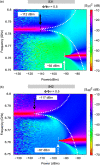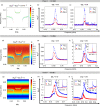Microwave quantum diode
- PMID: 38245544
- PMCID: PMC10799849
- DOI: 10.1038/s41467-024-44908-w
Microwave quantum diode
Abstract
The fragile nature of quantum circuits is a major bottleneck to scalable quantum applications. Operating at cryogenic temperatures, quantum circuits are highly vulnerable to amplifier backaction and external noise. Non-reciprocal microwave devices such as circulators and isolators are used for this purpose. These devices have a considerable footprint in cryostats, limiting the scalability of quantum circuits. As a proof-of-concept, here we report a compact microwave diode architecture, which exploits the non-linearity of a superconducting flux qubit. At the qubit degeneracy point we experimentally demonstrate a significant difference between the power levels transmitted in opposite directions. The observations align with the proposed theoretical model. At - 99 dBm input power, and near the qubit-resonator avoided crossing region, we report the transmission rectification ratio exceeding 90% for a 50 MHz wide frequency range from 6.81 GHz to 6.86 GHz, and over 60% for the 250 MHz range from 6.67 GHz to 6.91 GHz. The presented architecture is compact, and easily scalable towards multiple readout channels, potentially opening up diverse opportunities in quantum information, microwave read-out and optomechanics.
© 2024. The Author(s).
Conflict of interest statement
The authors declare no competing interests.
Figures






References
-
- Wendin, G., & Shumeiko, V.S. Superconducting Quantum Circuits, Qubits and Computing. arXiv:cond-mat/0508729 (2005).
-
- Devoret, M.H., Wallraff, A. & Martinis, J.M. Superconducting Qubits: A Short Review. arXiv:cond-mat/0411174 (2004).
-
- Gu X, Kockum AF, Miranowicz A, Liu Y, Nori F. Microwave photonics with superconducting quantum circuits. Phys. Rep. 2017;718:1. doi: 10.1016/j.physrep.2017.10.002. - DOI
-
- Ronzani A, et al. Tunable photonic heat transport in a quantum heat valve. Nat. Phys. 2018;14:991. doi: 10.1038/s41567-018-0199-4. - DOI
LinkOut - more resources
Full Text Sources
Research Materials

